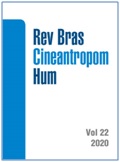Desenvolvimento e validação de uma equação para estimar a gordura corporal em mulheres idosas
Resumo
O objetivo do presente estudo foi desenvolver e validar uma equação de predição para avaliação da composição corporal utilizando-se medidas antropométricas de idosas. Este é um estudo transversal e correlacional com 243 idosas ± 64.5 anos de idade e índice de massa corporal (IMC) ± 28.70 kg/m². Para o desenvolvimento da equação utilizou-se o método de validação hold-out. As participantes foram divididas aleatoriamente em um grupo para desenvolvimento da equação (96 idosas) e um grupo para validação da equação (147 idosas). Massa corporal total, estatura, circunferências da cintura e quadril, relação cintura-quadril e IMC foram mensurados. A absorciometria por raios-X com dupla energia (DXA) para todo corpo foi utilizada para avaliação da composição corporal (percentual de gordura, massa gorda e massa livre de gordura). As equações foram desenvolvidas utilizando a regressão linear múltipla, com validação pelo método stepwise; a comparação das equações foi realizada pelo Teste T para amostras pareadas e análise dos escores residuais por meio do método de Bland e Waltman. A Nova Equação apresentou uma forte correlação (R = 0.83) e (R2 = 0.69), e uma estimativa de erro padrão de 3.21% para predição do percentual de gordura. A diferença média entre as estimativas de percentual de gordura pelo DXA e Nova Equação foi de 0.11% (t(0,180); P = 0.850). Assim, a Nova Equação teve uma precisão de 93.5% e um erro total de 1.8%. A estimativa do percentual de gordura em idosas usando a Nova Equação baseada no IMC e idade são válidos e precisos.
Referências
Santanasto AJ, Goodpaster BH, Kritchevsky SB, Miljkovic I, Satterfield S, Schwartz AV, et al. Body composition remodeling and mortality: the health aging and body composition study. J Gerontol A Biol Sci Med Sci 2017;72(4):513–9.
Chang S-H, Beason TS, Hunleth JM, Colditz GA. A systematic review of body fat distribution and mortality in older people. Maturitas 2012;72(3):175–91.
Fantin F, Francesco V Di, Fontana G, Zivelonghi A, Bissoli L, Zoico E, et al. Longitudinal body composition changes in old men and women: interrelationships with worsening disability. J Gerontol A Biol Sci Med Sci 2007;62A(12):1375–81.
Goodpaster BH, Krishnaswami S, Resnick H, Kelley DE, Haggerty C, Harris TB, et al. Association between regional adipose tissue distribution and both type 2 diabetes and impaired glucose tolerance in elderly men and women. Diabetes Care 2003;26(2).
Newman AB, Yanez D, Harris T, Duxbury A. Weight change in old age and its association with mortality. J Am Geriatr Soc 2001;1309–18.
Miller SL, Wolfe RR. The danger of weight loss in the elderly. J Nutr Health Aging 2008;12(7):487–91.
Lee CG, Boyko EJ, Nielson CM, Stefanick ML, Bauer DC, Hoffman AR, et al. Mortality risk in older men associated with changes in weight, lean mass, and fat mass. J Am Geriatr Soc 2011;59(2):233–40.
Aniteli T, Florindo A, Pereira R, Martini L. Desenvolvimento de equação para estimativa da gordura corporal de mulheres idosas com osteoporose e osteopenia através da espessura de dobras cutâneas tendo como referência absorciometria por dupla emissão de raios X. Rev Bras Med Esporte 2006;12(6):366–70.
Deurenberg P, Weststrate JA, Seidell JC. Body mass index as a measure of body fatness: age- and sex-specific prediction formulas. Br J Nutr 1991;65(2):105-114.
Dupler TL, Tolson H. Body composition prediction equations for elderly men. J Gerontol A Biol Sci Med Sci 2000;55(3):180–4.
Tran ZV, Weltman A. Generalized equation for predicting body density of women from girth measurements. Med Sci Sports Exerc 1989;21(1):101-104.
Downloads
Publicado
Edição
Seção
Licença

Direitos Autorais para artigos publicados nesta revista são do autor, com direitos de primeira publicação para a revista. Em virtude da aparecerem nesta revista de acesso público, os artigos são de uso gratuito, com atribuições próprias, em aplicações educacionais e não-comerciais, desde que seja dada a atribuição. Esta obra foi licenciada com uma Licença Creative Commons Atribuição 4.0 Internacional - CC BY


